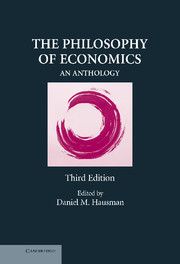Book contents
- Frontmatter
- Contents
- Introduction
- PART ONE CLASSIC DISCUSSIONS
- PART TWO POSITIVIST AND POPPERIAN VIEWS
- PART THREE IDEOLOGY AND NORMATIVE ECONOMICS
- PART FOUR BRANCHES AND SCHOOLS OF ECONOMICS AND THEIR METHODOLOGICAL PROBLEMS
- 16 Econometrics as Observation: The Lucas Critique and the Nature of Econometric Inference
- 17 Does Macroeconomics Need Microfoundations?
- 18 Economics in the Laboratory
- 19 Neuroeconomics: Using Neuroscience to Make Economic Predictions
- 20 The Market as a Creative Process
- 21 What Is the Essence of Institutional Economics?
- PART FIVE NEW DIRECTIONS IN ECONOMIC METHODOLOGY
- Selected Bibliography of Books on Economic Methodology
- Index
- References
17 - Does Macroeconomics Need Microfoundations?
Published online by Cambridge University Press: 05 June 2012
- Frontmatter
- Contents
- Introduction
- PART ONE CLASSIC DISCUSSIONS
- PART TWO POSITIVIST AND POPPERIAN VIEWS
- PART THREE IDEOLOGY AND NORMATIVE ECONOMICS
- PART FOUR BRANCHES AND SCHOOLS OF ECONOMICS AND THEIR METHODOLOGICAL PROBLEMS
- 16 Econometrics as Observation: The Lucas Critique and the Nature of Econometric Inference
- 17 Does Macroeconomics Need Microfoundations?
- 18 Economics in the Laboratory
- 19 Neuroeconomics: Using Neuroscience to Make Economic Predictions
- 20 The Market as a Creative Process
- 21 What Is the Essence of Institutional Economics?
- PART FIVE NEW DIRECTIONS IN ECONOMIC METHODOLOGY
- Selected Bibliography of Books on Economic Methodology
- Index
- References
Summary
As I observed in the first lecture, I chose Pissarides's model as a paradigm of the modern macroeconomic model for a variety of reasons: the clarity of its goals and exposition; the manner in which it attempted to relate its theoretical construction to empirical facts (at least in principle); and, by no means the least important reason, because it was the model that Nancy Cartwright held up as an example of a nomological machine in economics. A number of fellow economists, however, question whether Pissarides's model really is a macroeconomic model. Because it appears to model the decision problem of the individual worker and the individual firm, some economists regard it as a microeconomic model. But this is all the better for my purposes because there is a persistent refrain in recent macroeconomics that the only acceptable macroeconomic models are those that have adequate microfoundations.
The idea of microfoundations did not originate with the new classical macroeconomics, but the manner in which the new classical macroeconomics has dominated the agenda of macroeconomics over the past quarter century has firmly cemented it in the minds of virtually all economists. Lucas puts it clearly when he longs for an economics that does not need the prefixes “micro” or “macro” – sound economics is held to be microeconomics, and any macroeconomics that is not just a shorthand for the manner in which microeconomics is applied to certain problems is held to be bad economics.
- Type
- Chapter
- Information
- The Philosophy of EconomicsAn Anthology, pp. 315 - 333Publisher: Cambridge University PressPrint publication year: 2007



